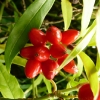Features
Attractively long, mid-green, evergreen leaves and bright red coloured oval berries over the autumn/winter months. Dark purple flowers appear in spring but are small and insignificant.
This plant is dioecious, so some plants will have male flowers and some will have females flowers. In order to produce berries, you need to ensure you are growing both male and female Aucuba japonica plants (or hope that your neighbour has some too!).
What to use it for
While the plain green leaves won’t do much to brighten a shady spot during the spring/summer, in the autumn and winter the red berries are a real treat. A good plant to use at the shady back of a border where it can recede into the background, while the summer border display is present, then come into its own in autumn/winter.
Could be used as hedging and in many different styles or gardens; formal or informal.
How to look after it
This is a pretty low maintenance plant. Straggly branches can be pruned out and a mulch of well-rotted compost or manure added in spring, but basically this plant will look after itself. If you want to keep it as a hedge, annual pruning will be required.
How to prune it
If your plant is bearing berries, prune it in mid spring. If not then you prune it earlier, in winter.
In the first spring after planting, prune back about one third of the length of the stems, pruning back to a bud. This should encourage bushier growth.
In subsequent years, restrict pruning to any over-vigorous shoots which spoil the shape of the bush and cut back any stems which have signs of die back, either to a healthy looking bud or all the way to the main stem. If you’re growing it as a hedge, you should trim it annually to keep it at the right size and a compact shape.
Hard pruning can help to rejuvenate bushes which have become bare at the base – over the course of 3 years cut all the main stems back to the base of the bush (ie cutting back one third of the existing stems each year).
All pruning, even of hedges, should be done using secateurs and not shears or hedge trimmers – otherwise you’ll cut through and damage the leaves which will then die back and look unsightly.
How to propagate it
This plant can be propagated easily in a number of ways. Semi-ripe cuttings can be taken in late summer and rooted in a cold frame or, for quicker results, with bottom heat of 21˚C (which will take 6 to 8 weeks). The cuttings can be potted on the following spring and will mature in 3 to 4 years.
Simple layering can also prove effective. Layer the plant in spring or autumn and the layers should be ready to be removed and planted on in 12 months.
Aucuba japonica can also be propagated by seed in autumn, although cultivars such as ‘Salicifolia’ may not come true from seed. Germination of the seeds (collected from ripe berries) may take up to a year and a half.
Common problems
This plant is generally pest and disease free.
They can be prone to die back and become bare at the base (see pruning information for tips on how to deal with this).
No berries! This plant is dioecious, therefore you need a male and a female Aucuba japonica to get berries.
Other useful information
Eating the berries may cause a mild stomach upset.








